
The holes in the wall are made accidentally during the repair of pipes or electrical systems, but also intentionally when we seek to hang any type of furniture or decorative object. That said, there are plenty of reasons to want to repair them and not in all cases you need the hand of a professional to do it for you. Next, we go into one of the most common domestic issues and we give you the steps to follow to repair a hole in any wall successfully.
As long as the hole is not too large or involves professional repairs that require your home insurance coverage, there are three effective ways to plug small cracks, scratches or thumbtack holes in the wall of no more than 5 mm, which will also be very useful for repairing other domestic damage such as defective anchors, broken plugs, disabled light boxes or pipes that are no longer used for anything.
First method: small holes
What do you need?
- A spatula (the size that best suits your needs)
- Sandpaper
- Wall Color Painting
- Conventional putty
Depending on the size of the hole (such as those due to nail or screw holes), you will need to use a more or less small spatula, which can introduce the putty more accurately. As for the putty, there are a variety of types on the market, but we recommend buying one that does not shrink to avoid gaps between the putty and the rest of the wall.
Some cracks between the mouldings or between the wall and the ceiling can also be repaired with putty, but if they are very fine the sealing paint can solve it more easily. Just apply a drop of paint along the crack and smooth with a finger moistened with water.
How we do it: if you have decided on the putty, mix a little of the product with water, stir until you get a pasty mass, apply a little on the spatula and try to fill the hole with it as much as possible.
The idea is that you extend the putty with the spatula until the surface is as smooth as possible. When the hole is completely full and the putty is dry, we sand over it to soften and homogenize the repair with the rest of the wall. Once it is smooth, we put paint of the same color.

Second method: medium sized holes
What do you need?
- Joint filler
- Gypsum board patch or tape
- Spatula
- Sandpaper
A medium sized hole is about the size of a golf ball. To get started, you’ll need to stick a patch or piece of plasterboard tape. In the case of patches, they adhere better to the wall and are specifically designed to plug medium sized holes, so they create a very practical surface to cover with putty and paint. In the case of plasterboard tapes, they are cheaper and you can get them at any store, but they leave a slightly coarser finish that is difficult to soften.
How we do it: we heal the hole with a plaster patch or tape, making sure it is completely covered. Next, we apply joint filler over the wall patch so we can smooth it out. If we use the tape, the procedure is the same; we can smooth out any remaining wrinkles with the spatula and putty.
We wait 24 hours for the putty to dry completely and we proceed to smooth the surface with sandpaper until it is smooth and homogeneous. We remove the dust completely before giving it a coat of paint and ready.
Third method: large holes
What do you need?
- Sandpaper
- A piece of plasterboard
- Tape and joint compound
- Gypsum plasterboard saw
- Cutter
A more complicated method that requires some level of concentration and precision, starting with the gypsum board you will need. Make sure it is the thickness of the wall you are going to repair and look for a piece the approximate size of the hole (you can get it at any store). When we have it, we will have to enlarge the hole in the wall to fit the piece of plaster, cutting the damaged contour with the saw and removing the remaining parts.
The next thing we need to do is cut another piece of plasterboard as close as possible to the hole we want to repair. This may take a little time, but with the saw it is possible to do it. Screw the piece of plaster to the crossbar with 15 cm screws in the spaces between the plaster and the wall, apply a layer of joint filler and let it dry.
Once it is dry, we stick a couple of plaster plates around the hole, apply putty on top to cover the tape and let it dry for 24 hours. Finally, sand the surface until it is as uniform as possible and apply a layer of paint.





